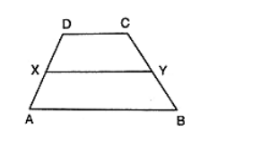In figure, ABCD is a trapezium in which AB || DC and DC = 40 cm and AB = 60 cm .If X and Y are, respectively,
In figure, ABCD is a trapezium in which AB || DC and DC = 40 cm and AB = 60 cm .If X and Y are, respectively, the mid points of AD and BC, prove that:
(i) XY = 50 cm
(ii) DCYX is a trapezium
(iii) ar(trap. DCYX) = (9/11) ar(XYBA).

(i) Join DY and produce it to meet AB produced at P.
In triangles BYP and CYD we have,
∠BYP = ∠ CYD [Vertically opposite angles]
∠DCY = ∠ PBY [Since, DC ∥ AP]
And BY = CY
So, by ASA congruence criterion, we have
(ΔBYP) ≅ (ΔCYD)
⇒ DY = Yp and DC = BP
⇒ Y is the midpoint of DP
Also, x is the midpoint of AD
Therefore, XY ∥ AP and XY ∥ (1/2) AP
⇒ XY = (1/2) (AB + BP)
⇒ XY = (1/2) (AB + DC)
⇒ XY = (1/2) (60 + 40)
= 50 cm
(ii) We have, XY ∥ AP
⇒ XY ∥ AB and AB ∥ DC
⇒ XY ∥ DC
⇒ DCYX is a trapezium
(iii) Since x and y are the mid points of Ad and BC respectively.
Therefore, trapezium DCYX and ABYX are of the same height say h cm
Now,
ar(trap. DCXY) = (1/2)(DC + XY) × h
$\Rightarrow \operatorname{ar}(\operatorname{trap} . \mathrm{DCXY})=(1 / 2)(50+40) \times \mathrm{h} \mathrm{cm}^{2}=45 \mathrm{~h} \mathrm{~cm}^{2}$
⇒ ar(trap. ABYX) = (1/2)(AB + XY) × h
$\Rightarrow \operatorname{ar}(\operatorname{trap} \cdot A B Y X)=(1 / 2)(60+50) \times \mathrm{h} \mathrm{cm}^{2}=55 \mathrm{~h} \mathrm{~cm}^{2}$
ar(trap. DCYX) ar(trap. ABYX) = 45h/55h = 9/11
⇒ ar(trap. DCYX) = 9/11 ar(trap. ABYX)
